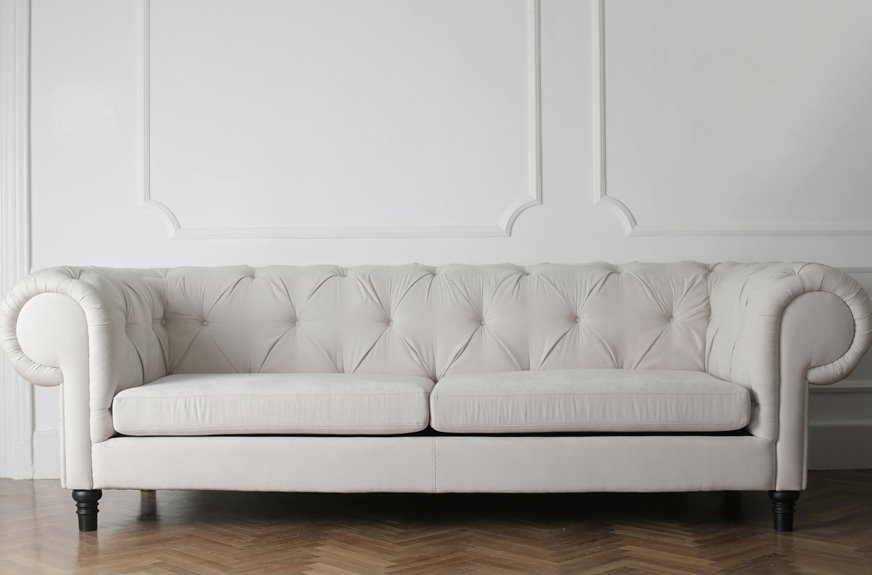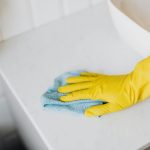You shouldn’t steam clean a leather sofa because the heat and moisture can damage it, causing discoloration, warping, or cracking. Leather is sensitive to steam, which can strip natural oils and weaken fibers. Different leather types react differently, but overall, steam isn’t safe for cleaning. Instead, use gentle soaps, microfiber cloths, and conditioners to maintain your sofa’s look and feel. Keep going to discover safer care methods and expert tips.
Table of Contents
Key Takeaways
- Steam cleaning leather sofas risks water damage, warping, and stripping protective coatings, especially for delicate or bonded leather types.
- Full-grain and top-grain leather are sensitive to moisture and heat, making steam cleaning potentially harmful.
- Excess moisture from steam can cause mold, cracking, and discoloration by weakening leather fibers and removing natural oils.
- Safer alternatives include using a damp microfiber cloth, mild soap solution, and leather-specific cleaners with conditioners.
- Professional cleaning services offer safe, effective deep cleaning and restoration tailored to your sofa’s leather type.
Understanding Leather Sofa Materials
Leather sofas come in various types, each requiring different cleaning methods. You might’ve a sofa made of full-grain leather, which is the most durable and natural, or top-grain leather, which is slightly processed for a smoother finish.
Then there’s corrected-grain leather, often embossed to hide imperfections, and bonded leather, made from leftover scraps mixed with polyurethane. Knowing your sofa’s material helps you avoid damage during cleaning.
For example, full-grain and top-grain leathers can handle gentle cleaning well, while bonded leather is more delicate. If you’re unsure about the type, check the manufacturer’s tag or documentation.
Understanding your sofa’s leather guarantees you pick a cleaning method that protects its texture, color, and longevity without causing harm.
How Steam Cleaning Works
The effectiveness of steam cleaning lies in its ability to combine heat and moisture to lift dirt and grime without harsh chemicals.
When you use steam, tiny water vapor particles penetrate the leather’s surface, loosening embedded dirt and oils. The heat from the steam also helps to kill bacteria and allergens, rejuvenating your sofa naturally.
You’ll see how this method:
- Revives the leather’s natural texture
- Removes stubborn stains gently
- Reduces the need for chemical cleaners
- Leaves your sofa feeling soft and clean
- Saves time compared to manual scrubbing
Potential Risks of Steam Cleaning Leather
When you steam clean your leather sofa, you risk water damage that can leave stains or cause warping.
The heat and moisture might also affect the leather’s surface, leading to cracks or loss of finish.
It’s important to understand these risks before you start cleaning.
Water Damage Concerns
Although steam cleaning can refresh your sofa, you need to be cautious about water damage risks.
Leather is sensitive to moisture, and excess water can seep into the material, leading to irreversible damage.
When you expose your leather sofa to too much steam, you risk:
- Stains caused by water spots that are tough to remove
- Weakening of the leather fibers, making it more prone to cracking
- Mold or mildew growth in hidden areas
- Warping or distortion of the sofa’s shape
- Fading or discoloration from water absorption
To protect your investment, always use minimal steam and dry the leather promptly.
If you’re unsure, consider consulting a professional to avoid costly mistakes and preserve your sofa’s beauty.
Leather Surface Integrity
Excess moisture isn’t the only threat steam cleaning poses to your leather sofa. The high heat and pressure from steam can disrupt the leather’s natural oils and finish, leading to cracks, discoloration, or a stiff texture.
When you expose leather to steam, you risk stripping away its protective coating, which compromises durability and appearance over time. Leather is sensitive; even brief exposure to intense heat can cause irreversible damage.
If your sofa’s surface starts feeling rough or looks dull after cleaning, it’s likely the leather’s integrity has been affected.
To keep your leather sofa looking great, it’s best to avoid steam cleaning and opt for gentler, leather-specific care methods that preserve its natural condition and extend its lifespan.
Types of Leather and Their Sensitivity to Steam
Leather comes in several types, each reacting differently to steam cleaning. You need to know which type your sofa has before you start.
Different leather types react uniquely to steam cleaning—identify your sofa’s material before you begin.
- Full-grain leather: Highly durable but sensitive to excessive moisture; steam can cause discoloration.
- Top-grain leather: More treated, slightly more resistant, but still vulnerable to damage from steam.
- Corrected-grain leather: Has a protective coating, making it somewhat steam-resistant, but prolonged exposure can harm it.
- Split leather: More porous and absorbs steam quickly, increasing the risk of warping or staining.
- Bonded leather: Made from scraps and glue, very delicate and likely to deteriorate with steam.
Understanding your leather type helps you avoid costly mistakes and keep your sofa looking great.
Always proceed with caution when considering steam cleaning.
Signs Your Leather Sofa May Be Damaged by Steam
How can you tell if steam cleaning has harmed your leather sofa?
Watch for discoloration, such as dark spots or fading, which often means the heat or moisture has altered the leather’s finish.
If the surface feels stiff, brittle, or unusually dry, that’s a clear sign the steam has stripped away natural oils.
Cracking or peeling leather also indicates damage from excessive heat or moisture exposure.
Pay attention to any changes in texture—if the leather feels rough or uneven, it may have been compromised.
Additionally, watch for water stains or blotchy patches that didn’t exist before.
If you notice any of these signs after steam cleaning, stop using steam and switch to gentler methods to protect your sofa’s appearance and longevity.
Preparing a Leather Sofa for Cleaning
Before you start steam cleaning, check your sofa’s leather for any cracks or damage that could worsen with moisture.
Next, gather all necessary supplies like a soft cloth, mild cleaner, and your steam cleaner.
Being prepared helps you clean effectively without causing harm.
Assess Leather Condition
Although steam cleaning can refresh your sofa, you’ll want to check its condition carefully first. Leather is delicate, and if it’s cracked, peeling, or overly dry, steam might cause more damage.
Take a close look at your sofa’s surface and feel the texture gently. Look for:
- Cracks that could widen with moisture
- Areas where leather peels or flakes
- Dry spots that might absorb steam unevenly
- Stains or discoloration that need special care
- Weak seams or loose stitching
Knowing these details helps you decide if steam cleaning is safe or if you should try gentler methods.
Evaluating your leather’s condition protects your sofa and guarantees your cleaning efforts actually improve its look and feel, not harm it.
Gather Cleaning Supplies
When you’re ready to clean your leather sofa, gathering the right supplies guarantees you tackle the job effectively and safely. You’ll need gentle tools and products that protect the leather’s finish while removing dirt and grime. Avoid harsh chemicals or rough materials that can damage the surface.
Here’s a quick checklist to prepare:
| Supply | Purpose |
|---|---|
| Soft microfiber cloth | Wipes surface without scratching |
| Leather cleaner | Removes dirt without harming leather |
| Distilled water | Prevents mineral deposits |
| Soft brush | Gently loosens dirt in crevices |
| Leather conditioner | Restores moisture and suppleness |
Having these on hand guarantees you clean thoroughly without risking damage to your leather sofa.
Safe Cleaning Alternatives to Steam
Since steam cleaning can sometimes damage leather, you’ll want to evaluate safer alternatives that effectively clean without risking harm.
Steam cleaning may harm leather, so consider gentle, safer cleaning methods to protect your sofa’s finish.
Using gentler methods preserves your sofa’s texture and appearance while removing dirt and stains. Here are five safe cleaning alternatives to evaluate:
- Damp microfiber cloth: Gently wipe away surface dust and grime without soaking the leather.
- Mild soap solution: Mix a few drops of gentle soap with water, then lightly clean with a soft cloth.
- Leather conditioner: Nourishes and protects leather while lifting light dirt.
- Vacuum with brush attachment: Removes debris from crevices without scratching.
- Spot cleaning with isopropyl alcohol: Use sparingly to target tough stains but test first.
These options keep your sofa looking fresh without risking damage from harsh treatments.
Recommended Products for Leather Sofa Care
To keep your leather sofa looking its best, you’ll want to choose products designed specifically for leather care.
Start with a gentle leather cleaner that removes dirt without stripping natural oils. Avoid harsh soaps or all-purpose cleaners, as they can dry out the leather.
After cleaning, apply a quality leather conditioner to nourish and protect the material, preventing cracks and fading. Look for conditioners with natural ingredients like beeswax or lanolin.
For regular maintenance, use a microfiber cloth to dust your sofa and a pH-balanced leather protector to shield against spills and stains.
Always test any product on a small, hidden area first to guarantee it doesn’t discolor or damage the leather.
Proper care products will keep your sofa soft, supple, and attractive for years.
Professional Cleaning Services for Leather Furniture
Though using the right products helps maintain your leather sofa, some stains and wear require more than at-home care. When you face tough grime, discoloration, or deep cracks, professional cleaning services step in to restore your furniture’s beauty and durability.
For stubborn stains and deep wear, professional leather cleaning restores your sofa’s beauty and durability beyond home care.
Experts use specialized equipment and gentle, leather-safe solutions to clean without damage. Hiring pros means you get:
- Confidence your sofa won’t be harmed
- Deep cleaning that removes embedded dirt
- Restoration of leather’s natural oils and suppleness
- Expert advice tailored to your sofa’s type and condition
- Extended life for your cherished furniture
If you want your leather sofa to look its best without risking costly mistakes, trust professionals who understand leather’s unique needs.
Tips for Maintaining Leather Sofa Longevity
To keep your leather sofa looking great, you should regularly apply a conditioner to prevent drying and cracking.
You also want to avoid exposing it to excess moisture, which can damage the leather.
These simple steps will help extend the life of your sofa and maintain its appearance.
Regular Conditioning Benefits
Even if you clean your leather sofa regularly, skipping conditioning can lead to dryness and cracking over time.
Conditioning replenishes natural oils, keeping your sofa soft and supple. It also protects against wear and tear, maintaining its luxurious feel and appearance.
When you condition your sofa, you:
- Preserve its rich color and prevent fading
- Soften the leather to avoid uncomfortable stiffness
- Extend the lifespan, saving you money on replacements
- Shield it from minor scratches and scuffs
- Maintain a welcoming, cozy atmosphere in your living space
Avoiding Excess Moisture
Conditioning your leather sofa keeps it soft and durable, but you also need to watch how much moisture it encounters. Excess moisture can cause leather to warp, stain, or develop mildew. When cleaning, use a damp—not soaked—cloth, and avoid steam cleaners unless specifically recommended. If spills happen, blot immediately to prevent absorption. Keep your sofa away from humid areas or direct water sources.
| Moisture Level | Risk to Leather | Recommended Action |
|---|---|---|
| Low | Safe | Regular light cleaning |
| Moderate | Potential staining | Blot spills quickly |
| High | Warping, mildew | Avoid moisture, dry quickly |
| Excessive Steam | Damage, cracking | Do not use steam cleaning |
Control moisture to preserve your sofa’s beauty and longevity.
Frequently Asked Questions
Can Steam Cleaning Remove Pet Odors From a Leather Sofa?
You can use steam cleaning to reduce pet odors on your leather sofa, but it might not eliminate them completely. Be cautious, as steam can damage leather; combining steam with leather-safe cleaners works best to freshen it up.
How Often Should I Clean My Leather Sofa to Prevent Damage?
You should clean your leather sofa so often it feels pampered like royalty, but realistically, every 3-6 months is enough. Regular dusting and conditioning prevent cracks and keep it soft, fresh, and damage-free.
Is It Safe to Steam Clean Leather Sofa Cushions Separately?
You shouldn’t steam clean leather sofa cushions separately because steam can damage the leather’s finish and cause drying or cracking. Instead, use a damp cloth and leather cleaner to gently clean them without risking harm.
Can Steam Cleaning Fix Scratches on a Leather Sofa?
Think of scratches as gentle whispers on your leather’s surface. Steam cleaning won’t erase them, but you can soften their appearance with leather conditioners and careful buffing, helping your sofa look refreshed without harsh treatments.
What Is the Best Way to Dry a Leather Sofa After Cleaning?
After cleaning your leather sofa, you should gently pat it dry with a soft, absorbent cloth. Avoid direct heat or sunlight; instead, let it air dry naturally in a well-ventilated room to prevent damage or cracking.
- Where to Buy Sherpa Suede Fabric - July 12, 2025
- How to Draw or Illustrate the Texture of Suede Fabric - July 12, 2025
- What Is Baseball Suede Leather Fabric? - July 12, 2025







